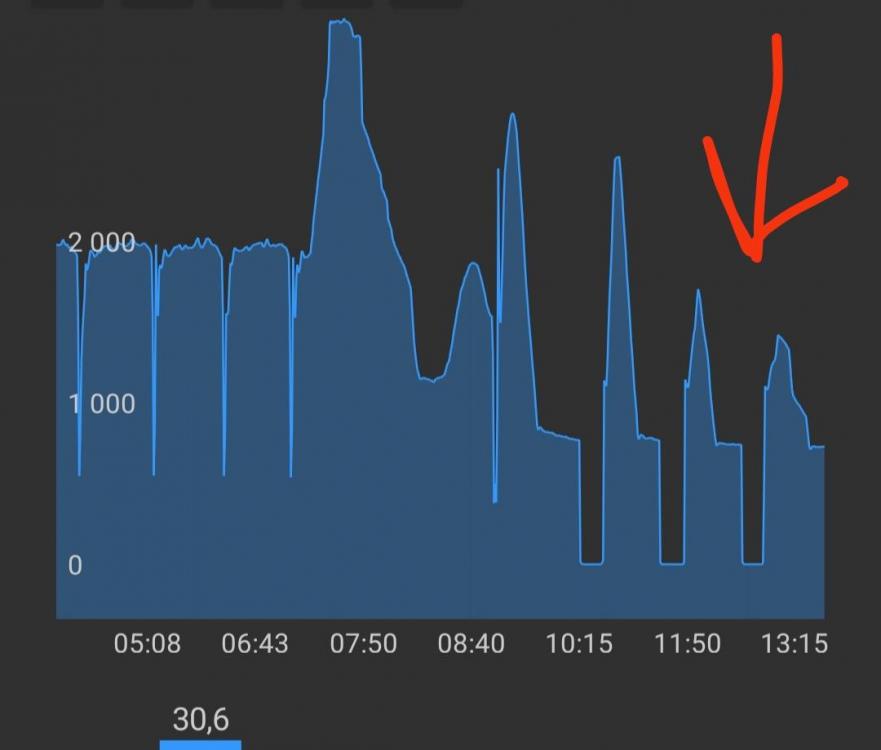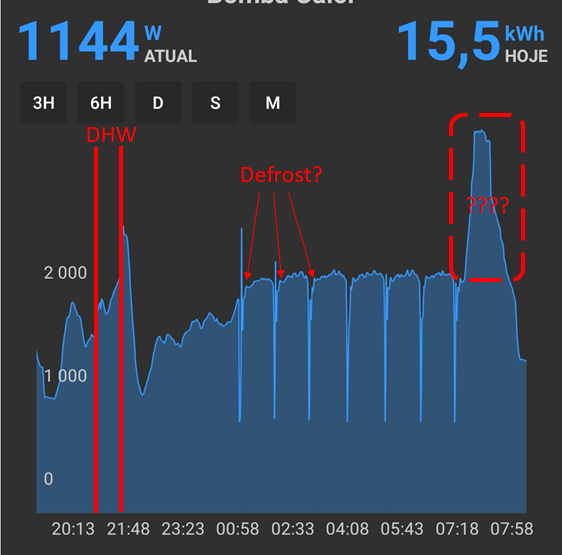
Bruno
Members-
Posts
87 -
Joined
-
Last visited
Recent Profile Visitors
The recent visitors block is disabled and is not being shown to other users.
Bruno's Achievements

Member (3/5)
7
Reputation
-
Well, most of the times that we open the door to stick more wood in some smoke does come out. Or when for some reason the fire is not "ramping up" (the wood is not always in the best condition) and you need to do something about it, there's usually a large amount of smoke inside which tends to come out as soon as the door is opened. In days of extreme wind it's not uncommon to have the smoke pushed inside (I assume that this might be caused by a bad construction of the chimney, although I know this from many many fireplaces in different houses).
-
That was exactly my reasoning. I grew with fireplaces all my life, and I got a log burner with boiler for the heating quickly after buying my apartment, which was used for years. And then I installed the ASHP last year. And then I had the house comfortable, no mess with the wood, cleaning the floor and the ashes, the smell of smoke inside the living room... and I never used wood again That "magic" of the fireplace might disappear quickly once you replace it with comfort and cleanliness. Just saying Anyway if you really want the wood burner I would second @ProDave's comment.
-
I have a similar setup (which I regret already, I never wanted to burn another log after I have the AHSP running?) This can be achieved either with a buffer tank which has 2 separate inputs (one from the burner and the other from the AHSP) or with "single-direction-flow" valves (sorry, no idea what's the English name for it) on the single input of the buffer tank (this was the option my installer chose in order to have a smaller buffer tank - separate input tanks are always bigger). This, however, has a big problem which must be taken care of: usually the circulating pump after the buffer tank (which goes to the radiators) is controller by the heat pump. When you are using the log burner, the heat pump will stop and so will the circulating pump. This is dangerous as too much heat can build in the buffer thank. It is therefore necessary to create a secondary command to the circulating pump: it is either activated by the AHSP or by the circulating pump of the log burner's water circuit. edit: IMO don't do it What you can do is take that money and replace your radiators with bigger ones, if possible ventilated. If you increase its emitting capacity you can work with lower flow temperatures and therefore increase efficiency. And don't forget insulation. Any heating source that you choose will need to restore whatever energy the house looses, so less losses less heating requirements.
-
Ah! What about that. Really easy. I wish I could kill emoncms and have the sensors directly connected to HA but that doesn't seem to be possible. However, to integrate emoncms feeds into HA works like a charm. Now I just need to know whether or not my old rpi3 can handle both emoncms+HA ?
-
Thank you Further updates: Today I bumped the day timperature to 23º. It was also a bit warmer outside so the flow temperature really didn't change much. The equipment did not cycle often (only 3 times in 8h), but the power consumption was always very low. Setpoint was at 23º, room temperature at 20,5º maximum. It seems clear that the compensation of room temperature is as I read it from the manual. I might get in touch with Vaillant to clarify this. In other news I temporarily set up home assistant in a virtual machine (I want to later move it to a rpi) and sucessfully integrated multimatic. It's really easy and I have have never worked with HA before. It's as slow as the app and fails as often to fetch values ? Unfortunately since I connected the buffer tank sensor I lost the flow temperature in the app, and it seems that in the integration as well. I need to check if there are further values which the API can fetch. And I would need to be able to change my energy meters from emoncms to HA. That will be a problem... While looking for information on how to do this I came across this video Managing heating in Home Assistant - part1 - YouTube In the first 5 minutes the author describes a heating behavior which is precisely like mine - but on a gas boiler. Outside temperature translated to flow temperature. So I guess I'm not alone in this...
-
Not really. It works with the Internet gateway and polls the data like the multimatic app (probably equally as slow ?) https://community.home-assistant.io/t/vaillant-multimatic-integration/87240
-
Thought about that, but I'm honestly puzzled about this and I'm curious to figure it out ? Well the manual I have is neither of those ? I have a "basic diagram block" for VRC700f/4 (which is correct) but it's from 2016, so it's totally useless for me... ??♂️ In other news I just got home, it's night and getting colder, so now the heat pump is now working continuously as it should. It's been cycling all afternoon with the room temperature still below setpoint. Looking at the manual where the parameters are described, I guess it's probably working as it should, although "what it should" might be kinda wrong ? Temp. mod.: The built-in temperature sensor measures the current room temperature in the reference room. This value is compared with the target room temperature and, if there is a difference, results in adjustment of the flow temperature by means of the so-called "Effective target room temperature". Effective room temp. target = set room temp. target + (set room temp. target - measured room temp. target). The effective target room temperature is then used for controlling instead of the set target room temperature. So basically what is happening is that I have 1,5° error which is added to my setpoint, which shifts the curve a bit. Taking those 14° outside, that would make flow temperature go from ~30° to some ~33° according to my current curve. Which is still not even close to enough with rads. Because the behaviour at night is now fine with very cold nights I would like to keep the current curve. And looking at the curve, I honestly don't see any other (even 4) which produces decent flow temperature with average outside temperature... Apart from the dynamic heating curve, I'm not sure if there is any further compensation over time. Maybe I'll try that. @J1mbomentioned in other topic a degree/minute compensation, but I have not find anything about that in any documentation... First I'll just set a higher setpoint during the day. I'm also preparing an integration with home assistant which hopefully will allow me to log more data.
-
I don't have that manual as mine is the VRC700, not the 720. But that makes me even more confused, so it's the VRC which defines the schematic and not the heat pump itself? ? Because the manual that I followed suggests parameters for both the 700 and 720. I can set it back to 8 for testing, not a problem. All of this started because I thought that 8 was wrong ?
-
I've been using the manual I linked in the first post as the first page says "for aroTHERM plus" and mine is just that ? I will see if I kept the printed manuals which came with the equipment later today. This is my setup and the configuration in page 5 says that "basic system diagram" is 10. I do, however, have a 100l buffer tank instead of a smaller (40l) as the manual says...
-
The VRC700 only shows the temperature in 0,5º steps but I have a digital thermometer (xiaomi) next to and the readings are within that 0,5. For the outside temperature it's not that easy to check. Before when it was getting direct sunlight, it was measuring totally exaggerated values during the day, but now it isn't anymore. So I would say that it is now accurate. But anyway I'm reading both temperatures in VRC700's display so that's also what the equipment "sees". What I see from the buffer tank (in Multimatic) is that it's temperature is more or less OK with the curve: outside temperature 14,5, curve 0,9, setpoint 22º --> temperature in the buffer tank 36,5º (not sure what's the real flow temperature but I'd say it should be more or less that). However the room temperature is 1,7º below setpoint (and still dropping) and the heat pump seems to not care. Tomorrow I will boost the "day temperature" to 23º and check if a bigger difference makes the HP "notice it".
-
COP calculations aside? any thoughts about this? edit: just looked at it again, 14,5º outside (so warmer), 20,3º inside. The room is still loosing temperature.
-
Oh, I had no idea. Thanks My meter says 21,1kWh up to now, vaillant says 20kWh. Environmental yeld is 33kWh. So COP is 2,57 I'm still totally confused with be heating behaviour, can't get my head around this... Last night was cold, so flow temperature was high according to the curve. Higher consumption but the room temperature was kept. Now it's sunny, 13° outside. I already fixed the temperature sensor's position so it reads fine now. I bump the setpoint temperature to 22° on the "day" program, room temperature is only 20,5°. But the heat pump is stopping, because as it gets warmer outside, it reduces the flow temperature. This makes really no sense to me... I'm planning on installing solar panels also as a way to reduce the cost of heating during the day, but it seems a waste as the heat pump is only effectively heating the house at night...
-
Output energy/consumed energy. Not? ?
-
The last few nights were very cold again (1º at 8h00), still very dry and sunny days. This was this evening's consumption graph, much similar to previous nights. Something I noticed is that after defrost kicks in (if that's really defrost, I have no way to confirm it) the consumption stays high at ~~2kW and never decreases again. Before the first defrost cycle consumption was much lower. I have absolutely no idea what is that peak at the end (did not happen in previous nights). I only noticed this because it becomes a bit noisy when working at full power, so I went to check the energy meter. I did check the unit's reported energy output and it was at ~~24kWh for today (so after 00h00), which means a ~~1,5 COP. I guess that's what it takes when it's just above freezing outside ?
-
No matter which option you choose, you should note that any heating system will only need to restore the energy lost. You should really take insulation serious. That's why @Iceverge's answer does make some sense. Still regarding heating options, why not AC?
- 12 replies
-
- 1
-

-
- air source heat pump
- gas
-
(and 8 more)
Tagged with:




